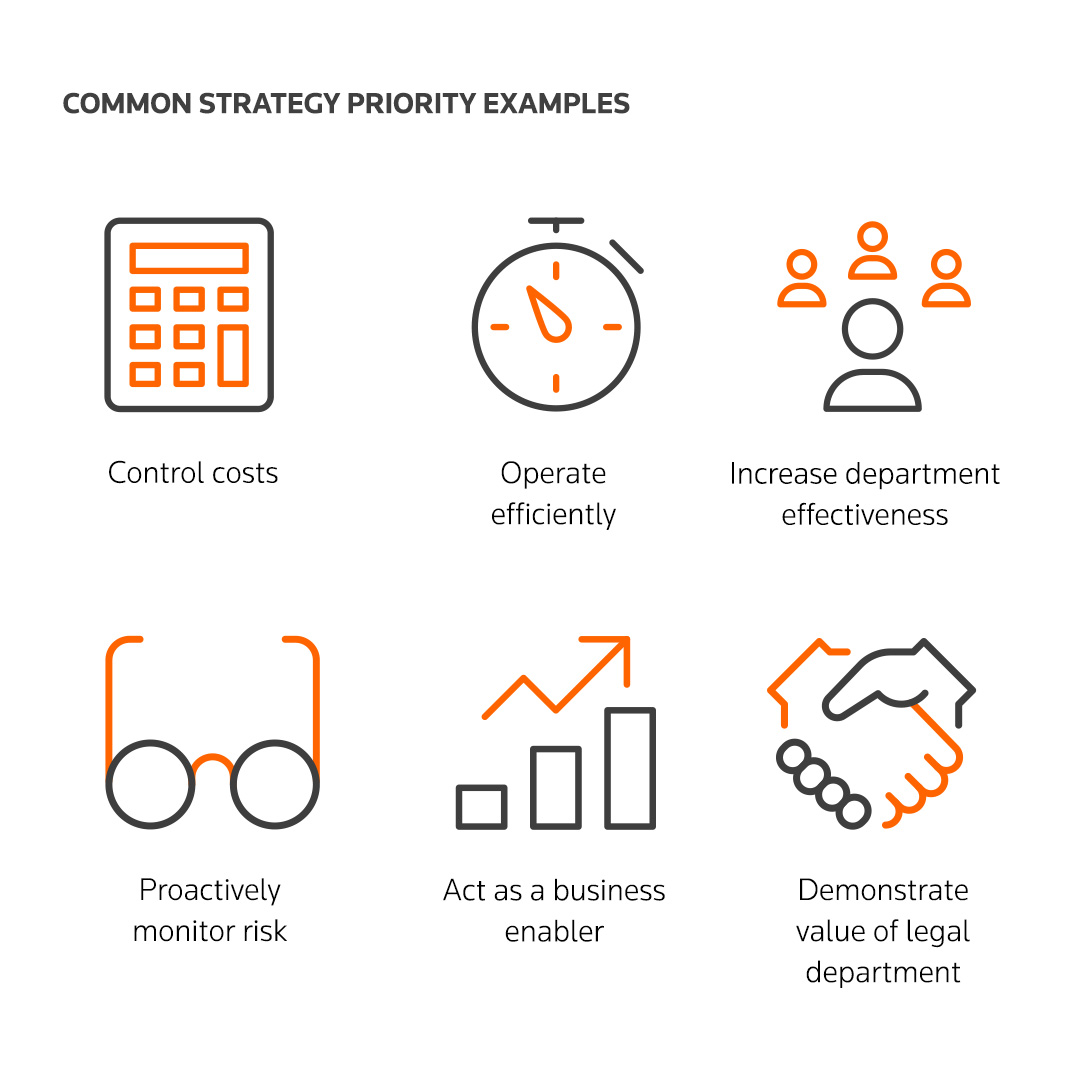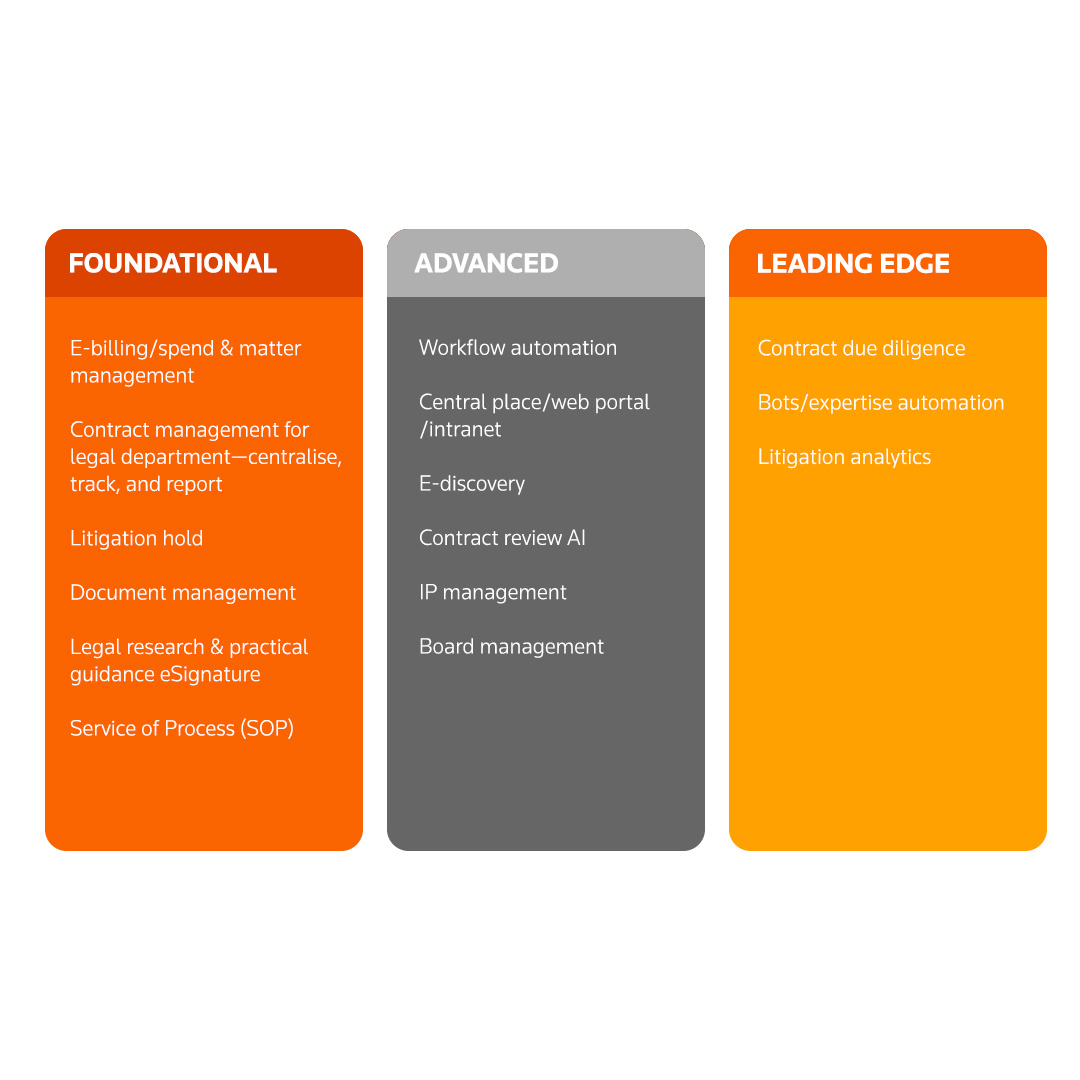Technology Roadmap Initiative
As companies continue to press their in-house legal departments to be more efficient and “do more with less,” the question of how to deliver better service with fewer resources remains a hot topic.
Departments that are managing this successfully uniformly credit a purposeful use of technology and data, to help them do their jobs better and demonstrate the value they deliver to the business. By deploying technology, the legal department can better control costs and enable in-house lawyers to focus on strategic, higher-value work. Doing so can help reduce overall legal costs, freeing up investment for other areas of the business and ultimately create a competitive edge.
According to the 2022 Thomson Reuters Legal Department Operations (LDO) Index, more than seven in ten of today’s corporate legal departments identified the use of technology to simplify manual workflow and processes as a high priority. Half increased their use of legal technology tools in the previous 12 months, and more than a third saw their department’s legal technology budget increase.
We can expect this focus on tech to continue, to support the evolution of legal department processes. Indeed, Gartner has predicted that by 2025, in-house legal departments will have tripled their spend on legal technology compared to tech expenditure levels at the start of the decade.
A clearly defined legal technology roadmap that is aligned with business strategy is a critical tool to help your department control costs, drive efficiency and effectiveness, and ultimately add tangible value by acting as a business enabler.
Now, let’s take a deeper look at what a technology roadmap is, how to build one, and the risks of not having one.
What is a technology roadmap?
A legal technology roadmap is best defined as a plan that identifies the specifics of how technology can support the legal business strategy and priorities over a period of time (typically three years).

How to start building a roadmap
-
Prioritise
What are the biggest pain-points/challenges that map to the strategic priorities for the legal department?

If you don’t have clear strategic priorities for the legal department, you can start by surveying the legal department and/or business stakeholders that regularly interact with legal on areas of greatest need.
-
Process map
Before building a plan, you must understand the current people, processes, and systems in place. You can start by listing out current systems used by the legal department and by looking at the common legal department responsibilities, or the most common business requests.
A great way to identify where process re-engineering or new technology is required is to look specifically at processes that are high-cost, difficult, cumbersome, time-consuming, repetitive, high-volume, and/or low-value. As you go a level deeper and map processes that lead to a need for technological improvements, make sure you define requirements and measures of success along the way.
-
Plan for implementation and/or procure solution
Technology roadmaps don’t always have to require the addition of new technology – you may have a system in place that needs an update based on business changes, or one that could be utilised to a greater extent.
Once you have a map of processes and priorities, don’t try to do it all at once. Instead, start with your highest priority – focus on achieving success in that area, then build on that success.
Look for solutions that can deliver cost savings, and promote and report on those cost savings to highlight success. Then re-allocate those savings to procure additional technologies or resources to tackle the next priority on your list to keep the momentum going.
What are the risks of not having a technology roadmap?
-
Lack of buy-in from the legal department or leadership when attempting a change
– An approved and clearly communicated roadmap will make the change management journey simpler
-
More difficult to secure budget when you find a solution
– A clear legal roadmap builds a better internal relationship with IT/Finance/Procurement for faster purchase
-
Ending up with the wrong technology at the wrong time
– As an example, you may not want to deploy a contract review AI tool before you have contracts stored in a central repository
-
Not considering interconnectivity and overall simplification of tools
– Planning will help avoid the risk of procuring too much technology that doesn’t work together
-
Lack of resources to ensure technology success
– A roadmap can help you determine what legal department staffing resources will be required to support implementation efforts, and how to partner with IT for support if you need it
-
Competitive disadvantage for your organisation
– If your rivals’ legal departments are deploying technology to control costs and doing more with less, and you’re not, you’re operating at lower levels of effectiveness and therefore you’re less competitive. This could result in your company having fewer available funds with which to address more strategic priorities.
How do I ensure I select the right solution for the needs of the legal department?
When vetting technologies, identify your priorities (see sample list of priorities on previous page) and deploy a simple 1-5 scoring system to help you compare and contrast solutions. Evaluate if the solution:
- Is end-user friendly
- Is designed for legal workflows
- Has strong data security and access controls
- Is quick to deploy
- Delivers measurable ROI/cost savings
- Provides an open platform with APIs to connect corporate systems
- Has quality connections to standard business tools like Microsoft® Outlook and Office®
- Integrates with enterprise systems like AP Systems, HR Systems
- Enables easy connection of legal workflows – e.g. between spend and matter management, contract management and eSignature, etc
- Is cloud-based
- Empowers legal department management (or ownership) with no code/low code to make updates and changes
- Delivers valuable reporting and data visualisation
- Uses modern technologies and capabilities
My legal department doesn’t have any technology outside of Microsoft Word and Outlook – where do I start?
When considering core solutions for your legal department:
- Focus on your area of greatest need
- Consider what solutions are:
– Foundational
– Demonstrate a clear return on investment
– Help your organisation minimise risk
In several surveys including the latest Corporate Legal Operations Consortium (CLOC) State of the Industry report2 and the LDO Index, eSigniture and e-billing/spend and matter management are the most widely adopted technologies for in-house legal departments. While some technologies deliver a broad-based approach to helping manage your legal operations, other simple tools like eSignature can yield significant benefits to drive efficiency within your business processes.
The sample list below outlines the most common legal department technologies in terms of what is foundational, advanced, and leading-edge depending on the sophistication of the department.

Ultimately, for your department you should focus on the areas of greatest need based on your prioritised roadmap.
Top 5 ranking of legal department technology solutions in order of importance
- E-BILLING/SPEND & MATTER MANAGEMENT
- ESIGNATURE
- LEGAL RESEARCH
- LEGAL HOLD/LITIGATION HOLD
- CONTRACT MANAGEMENT
LDO Index 2022
__________________________________________________________________
CONCLUSION
If you’re on a journey to improve your legal operations technology, the best place to start is with a technology roadmap. It is through this process and the resulting documentation that you’ll more clearly understand what you have, what you need, and how to get there. That way, you are more likely to succeed in controlling cost, driving efficiency, improving effectiveness, and mitigating risk.
To learn more how Thomson Reuters can help your law department demonstrate its value to the business, explore our corporate legal and software solutions.




